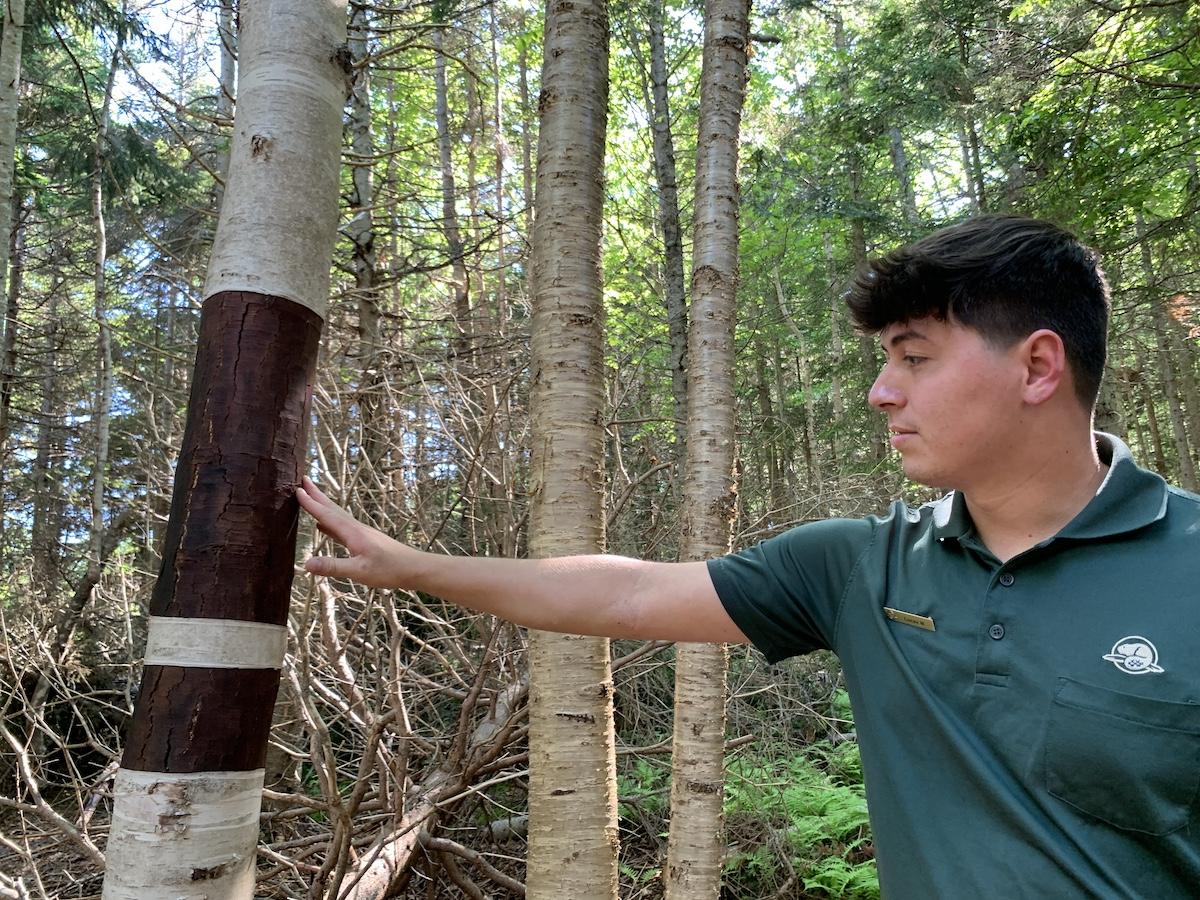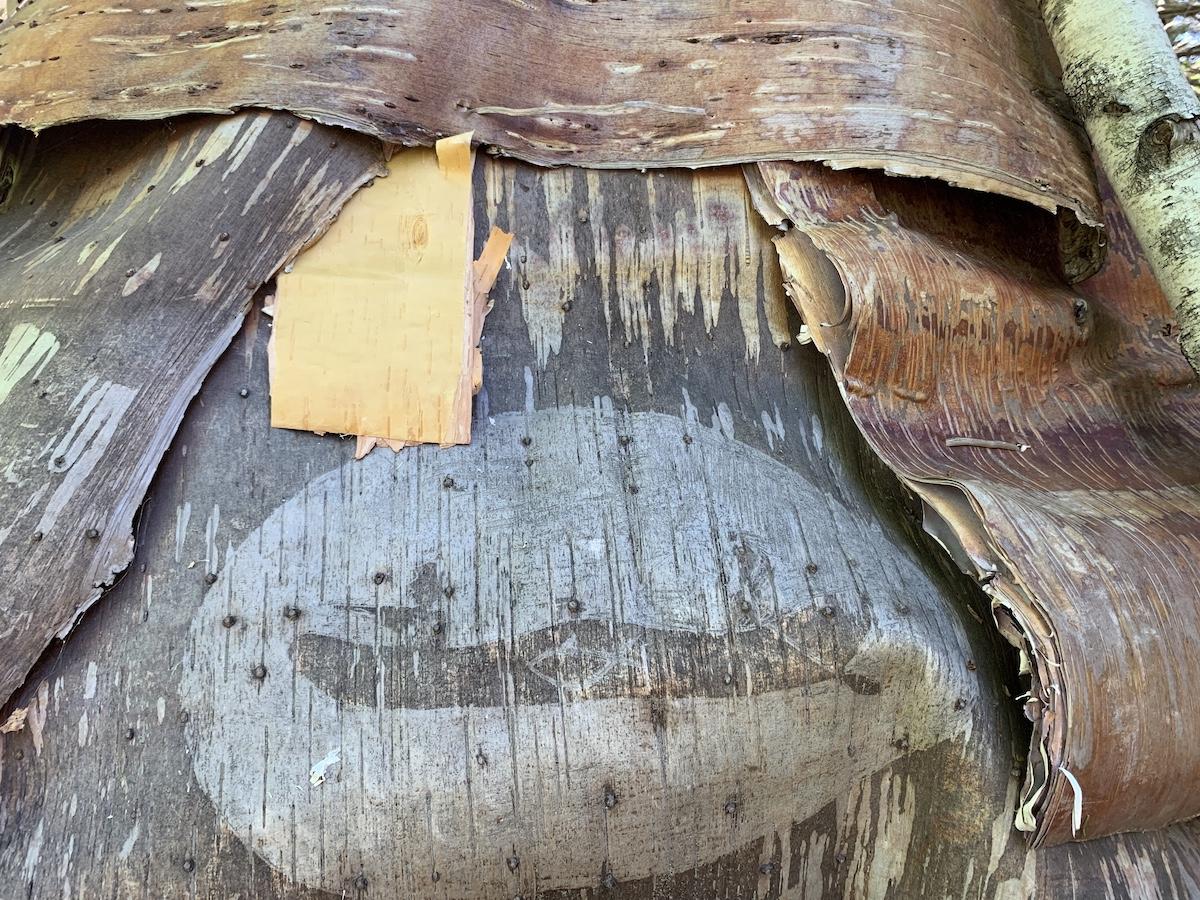
Parks Canada heritage presenter Lucas Milligan shows the wigwams at Skmaqn—Port-la-Joye—Fort Amherst National Historic Site/Jennifer Bain
In a quiet patch of forest just off Skmaqn Trail and not far from eroding cliffs overlooking Charlottetown Harbour, Lucas Milligan waits patiently in a clearing beside a wigwam and a wigwam in progress. The Parks Canada heritage presenter is here to explain the Mi’kmaq connection to Skmaqn—Port-la-Joye—Fort Amherst National Historic Site, and that story usually starts with a translation of the word that’s pronounced Ska-MAA-kin.
Skmaqn is Mi’kmaq for “the waiting place” and it’s a named for the practice where Mi’kmaq leaders and elders would gather annually here on what’s now Prince Edward Island during the French regime at Port-la-Joye to celebrate and renew their “Grand Alliance” with the French.
French officials, grateful for the way the Mi’kmaq helped settlers adapt to this unfamiliar land, would travel from the Fortress of Louisbourg (in present day Cape Breton) to attend grand ceremonies with feasts, speeches and gifts.

Heritage presenter Lucas Milligan shows where birch bark has been carefully taken from a tree/Jennifer Bain
“Now we sit out here and wait for visitors,” explains Milligan, who was born here but grew up on a reserve in New Brunswick and now travels between Skmaqn and Prince Edward Island National Park’s Greenwich and Brackley-Dalvay sections to do Indigenous interpretive programming. He might detail how wigwams are made, play guitar or speak about the Park Promise, a short song/poem written around the seven directions/sacred teachings in collaboration with P.E.I.’s poet laureate Julie Pellissier-Lush, a knowledge keeper from Lennox Island First Nation.
The Mi’kmaq people moved seasonally through Mi’kma’ki (their traditional and current territories) and used spruce poles, balsam fir boughs, birch bark and animal hides to build wigwams close to the water and sources of fish and berries. They enjoyed a migratory lifestyle, living inland in the winter and along the coast in the summer, later trading furs and woven black ash baskets with settlers.
Milligan walks me down the Coastal Forest Path and shows how birch bark is carefully peeled off trees during the three hottest months of the year. The pliable bark is spread out over the poles of wigwams. Hot water can be poured on the bark so drawings can be etched into it.

A drawing of a canoe is etched into the birch bark covering the wigwam at Skmaqn/Jennifer Bain
Another short path — called Alliance Alley — also references the historic political alliance once formed between the Mi’kmaq and French officials. The Grand Alliance, as it was called, was one of just two that took place annually in North America.
“Sometimes the French would be weeks late, and the Mi’kmaq would wait and wait for them,” explains interpretation coordinator David Mason. To make it easy on the 30,000 or so visitors that come each year (at least pre-COVID), he tells them Skmaqn rhymes with toboggan.
Not only was this a place where the French and Mi’kmaq annually renewed their alliance, Skmagqn—Port-la-Joye—Fort Amherst National Historic Site, now under Parks Canada’s care, commemorates one of the first European settlements on Prince Edward Island and tells the story of the Franco-British struggle for imperial dominance of 18th century North America.
It’s a site where four cultures — Mi’kmaq, French, Acadian and British — converged and their friendships, conflicts and alliances set the stage for what would become P.E.I.
“A lot of people come and don’t really understand and think this is just a small site,” notes Mason. “It’s a major historical site and without it P.E.I. wouldn’t be as it is today.”

Two flags fly at the national historic site — a British flag and a French naval flag/Jennifer Bain
For the historically challenged, it’s hard to keep up with all the changing place names. What we now call Prince Edward Island has been home to the Mi’kmaq for more than 10,000 years and was first known as Epekwitk. French explorer Jacques Cartier arrived in 1534 as the island’s first European visitor, and then the French set up seasonal fisheries on the northern shore. The French renamed the island Île Saint-Jean.
Skmaqn, with sweeping harbor views, was an ideal setting for the strategic defence of a small colonial outpost. In 1720, three ships owned by la Compagnie de l’Isle Saint-Jean set sail from Rochefort, France with 300 settlers. Some of these new arrivals began building here at what they named Port-la-Joye while others settled elsewhere.
Michel Haché dit Gallant and his family came from Beaubassin and became one of the first known Acadian families to settle on the island, between the French outpost and the creek flowing into the cove in an area that became the heart of Port-la-Joye’s civilian community. The goal was to turn the settlement into a thriving agricultural community that could supply the French colonial stronghold of Louisbourg. The settlers built a chapel, storehouse, bakery, forge, powder magazine, barracks and commandant’s lodgings.

The Acadian Odyssey Monument commemorates the tragic expulsion of Acadians from P.E.I. in 1758/Jennifer Bain
But the British took control of this site in 1758 and renamed it Fort Amherst. They also ordered the mass deportation of more than 3,000 of the island’s French and Acadian settlers to France. Acadians are early French immigrants who settled in the New France colony of Acadia — now Nova Scotia, New Brunswick and P.E.I. — beginning in the early 1600 and felt independent from France.
“Half drowned,” says Mason, who shares his deep knowledge of the site's tumultuous history. “Seven hundred died of drowning. Nine hundred died of disease and starvation. Three ships sank.”
Set on a grassy hill overlooking the harbor, the Acadian Odyssey Monument details the broader scope of the deportation — known as the Grand Dérangement or Great Upheaval — which involved nearly 10,000 people across the east coast of Canada. Many died, some escaped and many never returned home.
“Many took root in Quebec and France, while in Louisiana they gave rise to a new community that produced the rich Cajun culture,” the monument explains. “Yet, the Grand Dérangement was unable to wipe out the Acadian presence on its native soil. L’Acadie lives on in Atlantic Canada, speaking French and offering to the world its proud and dynamic culture.”

Parks Canada interpretation coordinator David Mason knows the complex history of Skmaqn inside out. He stands by one of the site's fading and difficult to read interpretive signs/Jennifer Bain
In 1768, when Charlottetown became the colonial capital, the military moved across the harbor and established Fort Edward (now Victoria Park). Fort Amherst was abandoned and only a few ruins are visible today.
Skmaqn was added to the Port-la-Joye—Fort Amherst national historic site name in 2018 to recognize the the traditional name for the site and its Indigenous history. The year 2020 marked the 300th anniversary of the 1720 arrival of the French and Acadians on the island and the establishment of Port-la-Joye. Three new trees were planted — a white pine, red oak and white birch to represent three centuries of French and Acadian presence at the site. Somehow I miss checking to see how they're doing.
National Acadian Day, August 15, is always celebrated here.

Cliff erosion, accelerated by climate change, is an issue at Skmaqn. Locals use an unofficial path for beach access/Jennifer Bain
Skmaqn is an easy 20-minute drive from Charlottetown, where I base myself at the Rodd Royalty (sister property to the Rodd Charlottetown) and enjoy quick meals at the Founders Food Hall & Market. The island is famous for its red earth and potato crops, so I try potatoes, baked and topped Turkish style, at Dal's Potato Bar, as well as potato fudge at Oh Fudge, and hand-crafted dougnuts at Doughnuts by Design (which have nothing to do with potatoes). If you spot Acadian fricot on any menus while exploring the province, try it — it's a simple stew with chicken stock, potatoes and dried summer savoury. Some versions include carrots or potato dumplings.
And yet this understated national historic site isn't on the radar of most visitors. Parks Canada positions Skmaqn as “one of the best hidden gems of P.E.I.” — a place where locals watch Canada Day fireworks, walk their dogs and explore a six-kilometre (3.6-mile) trail system with nine routes, some that hug the coast and offer sweeping harbor view, and others that travel through peaceful wooded paths and over rolling meadows and green fields.
The trails are open year-round, but not maintained between mid-October and mid-June. The visitor reception center is only open in July and August. Indigenous interpreters are at the wigwam to share Mi'kmaq traditions, history, culture and language on Monday in July and August. Day-use washrooms are only available June 13 to Aug. 31.

A simple visitor reception center, open in the summer, has washrooms and a few interpretive signs/Jennifer Bain
On a busy day, pre-pandemic at least, Mason figures that Skmaqn gets just 80 or 90 visitors, despite its proximity to the capital city (that's just to the visitor center so if you go by the car counters, it's more like 220 to the site itself). Compare that to the wildly popular Green Gables Heritage Place — which celebrates the best-selling novel Anne of Green Gables and its P.E.I.-born author L.M. Montgomery, and where Mason used to work. It apparently draws upwards of 3,000 visitors a day.
It's interesting to compare budgets. Green Gables is getting $632,160 ($490,000 USD) for 2022-2023, and this includes 37 staff (full-time, seasonal, term and student). Skmaqn will get $59,612 ($46,000 USD), and this includes four staff (term and student).
For now, visitors to Skmaqn are largely left to explore on their own. Much of the interpretive signage sprinkled around the site is aged and faded, and some is out until fall for repairs.

A trilingual sign thanks people in English, French and Mi'kmaq for visiting Skmaqn/Jennifer Bain
“A lot of people will come just to see the cruise ships,” says Mason, as we stop to watch Holland America’s Zaandam pass by after a stop in Charlottetown. “As a kid, before I even worked here, I’d fly kites on the fort.”
New interpretive signs, he assures me, are in the works. For now, the trilingual English-French-Mi'kmaq signs at the site entrance and exit are clearly modern. It's from them that I pick up two important Mi'kmaq words.
"Pjila'si" means welcome.
"Wela'lin" means thank you.

 Support Essential Coverage of Essential Places
Support Essential Coverage of Essential Places




Comments
Beautiful, peaceful place. Place to connect with our past.